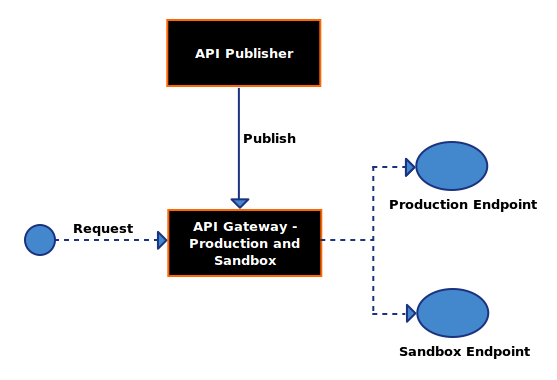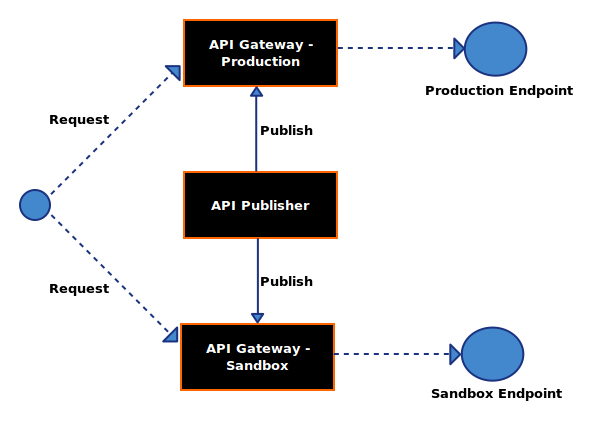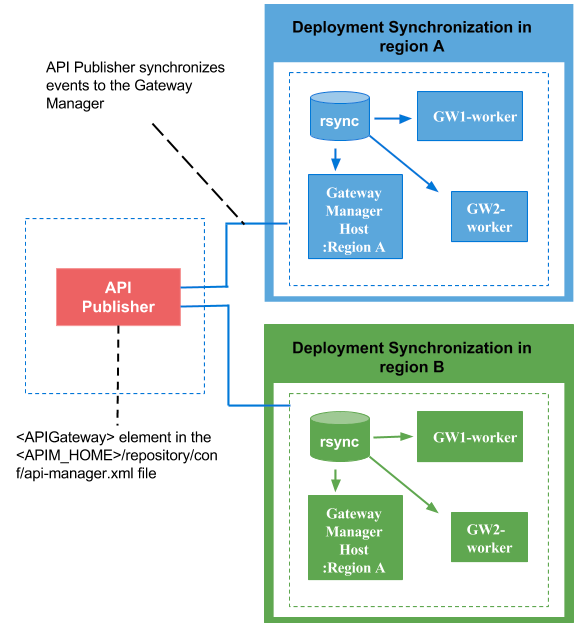Maintaining Separate Production and Sandbox Gateways¶
With WSO2 API Manager, you can maintain a production and a sandbox endpoint for a given API. The production endpoint is the actual location of the API, whereas the sandbox endpoint points to its testing/pre-production environment.
When you publish an API using the API Publisher, it gets deployed on the API Gateway. By default, there's a single Gateway instance (deployed either externally or embedded within the publisher), but you can also set up multiple Gateways:
Single Gateway to handle both production and sandbox requests¶
This is the default scenario. Because this Gateway instance handles both production and sandbox token traffic, it is called a hybrid API Gateway. When an API request comes to the API Gateway, it checks whether the requesting token is of type PRODUCTION or SANDBOX and forwards the request to the appropriate endpoint. The diagram below depicts this scenario.
Multiple Gateways to handle production and sandbox requests separately¶
Having a single Gateway instance to pass through both types of requests can negatively impact the performance of the production server. To avoid this, you can set up separate API Gateways. The production API Gateway handles requests that are made using PRODUCTION type tokens and the sandbox API Gateway handles requests that are made using SANDBOX type tokens.
The diagram below depicts this using two Gateways:
In either of the two approaches, if an API Gateway receives an invalid token, it returns an error to the requesting client saying that the token is invalid.
You configure production and sandbox Gateways in the <API-M_HOME>/repository/conf/deployment.toml file in API Publisher nodes, as shown in the following example:
[[apim.gateway.environment]]
name = "Production"
type = "production"
display_in_api_console = true
description = "This is the gateway that handles production token traffic."
show_as_token_endpoint_url = true
service_url = "https://localhost:9445/services/"
username= "admin"
password= "admin"
ws_endpoint = "ws://localhost:9099"
wss_endpoint = "wss://localhost:8099"
http_endpoint = "http://localhost:8282"
https_endpoint = "https://localhost:8245"
[[apim.gateway.environment]]
name = "Sandbox"
type = "sandbox"
display_in_api_console = true
description = "This is the gateway that handles sandbox token traffic."
show_as_token_endpoint_url = false
service_url = "https://localhost:9448/services/"
username= "admin"
password= "admin"
ws_endpoint = "ws://localhost:9199"
wss_endpoint = "wss://localhost:8199"
http_endpoint = "http://localhost:8285"
https_endpoint = "https://localhost:8248"The service_url parameter should have the value of the environment instance.
The type attribute of the environment can take the following values:
- Production : A production type Gateway
- Sandbox : A sandbox type Gateway
- Hybrid : The Gateway handles both types of tokens
If you work with Gateways in different geographical locations, configuring multiple environments in the <API-M_HOME>/repository/conf/deployment.toml file is recommended. The diagram below depicts a sample setup:
Figure : API Gateways in different geographical regions
Info
Note that in addition to the configuration mentioned above, all the other required configuration for Publisher and other Components should be done. If you are using a multi-tenanted setup, would need to share the registry database mount with the Gateway Sandbox and Production nodes.
Gateway Labels¶
Similar to Gateway Environments, you can use Gateway Labels to expose a particular Gateway. Once you expose an Gateway, you can choose from the API Publisher Portal, the API Gateways that the API should be deployed.
In previous versions of APIM, Gateway Labels were only used with Micro Gateway and not with the synapse Gateway.
With APIM 3.2.0 release, Gateway Labels acts similar to Gateway Environment in the architecture. Even though Gateway environments are added through a configuration as explained above,
Gateway Labels can be added dynamically from the admin portal.
However Gateway Labels only works if you have enabled artifact synchronization of Gateway runtime artifacts with Inbuilt Artifact Synchronizer. The Publisher-Subscriber architecture in the Inbuilt Artifact Synchronizer deploys the artifacts to the Gateways defined with Gateway Labels. For more information, see Inbuilt Artifact Synchronizer
Once you define a Gateway Label, Gateway deployment has to subscribe to that Label. Gateway deployment to Gateway Label has a many to many relationship. One Gateway deployment can subscribe to multiple Labels and One label can be subscribed by multiple Gateway deployments. Once the API publisher publish the API by selecting a Gateway Label, Publisher node will publish this event to all the Gateways in the deployment through Traffic Manager. If the Gateway is subscribed to that API Label, it will retrieve the artifact and deploy.
Tip
If you need to horizontally scale the Gateway cluster by adding a new Gateway node, you just need to subscribe to the same set of Labels and start the Gateway server. In the startup, Gateway will pull all the artifacts relevant to it's subscribed labels and deploy.
Info
In this architecture, Gateway Environments and Gateway Labels acts in a similar way. Defined Gateway Environment Name (Eg:"Production and Sandbox" will be used as the Label name.


